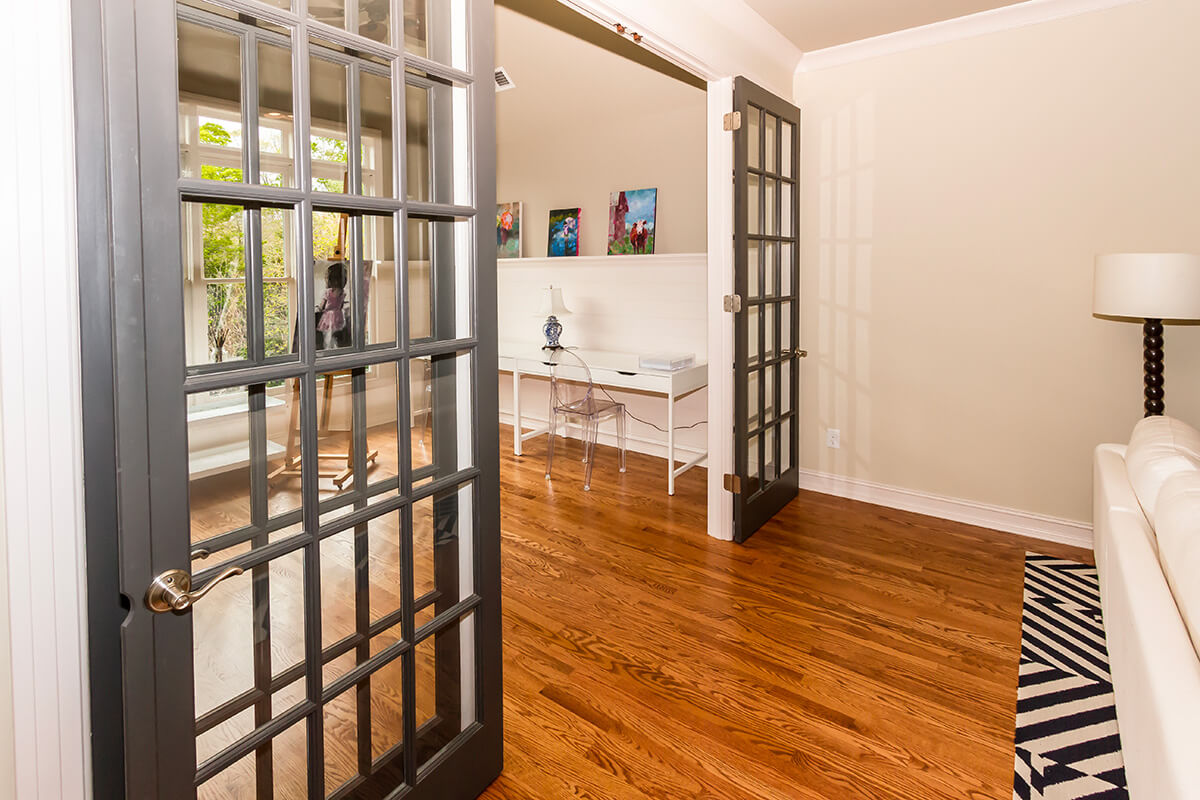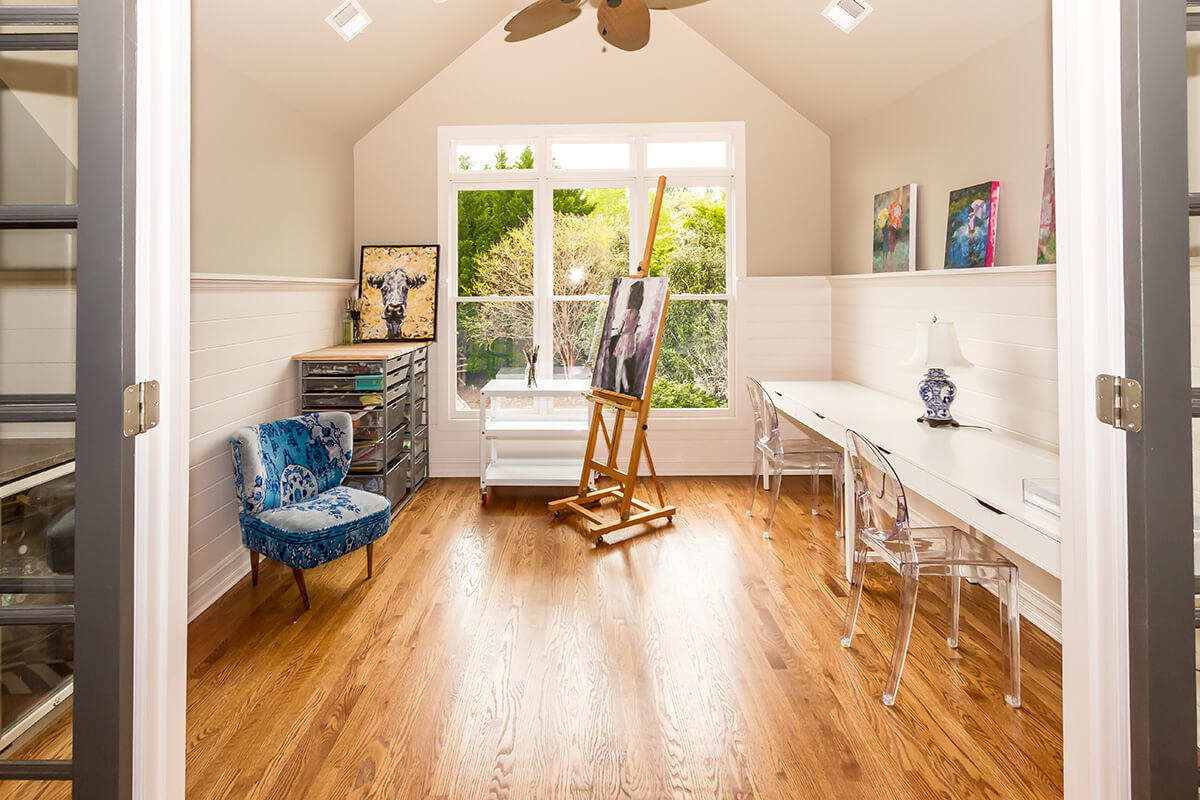Home Office Design Considerations: A Remodeler’s Perspective
As remodelers, it’s essential that we take a holistic approach to all home office design considerations to create a workspace that fits your needs and available space while integrating creativity and practicality. Whether you’re a full-time remote worker, a freelancer, or someone who occasionally needs a quiet place to concentrate, a well-designed home office can significantly boost productivity and comfort.
Before the pandemic, the home office was often an afterthought in home design. However, with the rise of remote work and virtual meetings, homeowners are now paying more attention to creating a functional and aesthetically pleasing workspace within their homes.
Here are some of our home office design considerations.

Remodeling a Home Office: The Considerations
Remodeling to create a home office requires careful planning. Begin by selecting a suitable location that is quiet and free from distractions. This might mean repurposing an unused guest room, converting an attic or basement space, or even designing a dedicated office nook within a larger living area. But before you settle on the final location, there are some things you should consider.
- Who is the office space for? Your personal preferences in how you like to work will greatly influence the design of your home office. Do you need a quiet, isolated space to focus, or do you prefer being close to the hustle and bustle of the household?
- What working space do you have available? Can you use an existing room, such as a bedroom, the dining room or the formal living room, or will you need to build an addition?
- What type of work will you be doing? This will determine the features and equipment that need to be incorporated into the design. For example, a smaller desk and workspace might suffice if you primarily use a laptop, but a larger workspace and storage area may be necessary if you’re an artist or designer.
- How much storage do you need? Adequate storage is crucial for keeping your home office organized and clutter-free. Consider incorporating built-in cabinetry, file cabinets or desk drawers into your design to maximize space efficiency.
Choosing the Ideal Location
The first essential step is selecting the right location from the options available. Hiring a professional remodeling firm can often help because they can see ways to utilize unused space and turn it into a fantastic home office area.
If you thrive in a tranquil environment, a secluded spot such as an attic, basement or a room with a door you can close might be ideal. These spaces offer minimal interruptions and allow you to concentrate deeply on your tasks.
In contrast, if you draw energy from the activities around you and enjoy quick, informal interactions with family, setting up your home office in a living area or near the kitchen might be better suited to your personality.
It is also important to consider how easily accessible basic amenities are. For example, being close to the kitchen for meal prepping or the outside entrance to let the dog in and out may be beneficial. Ultimately, understanding your working style and the environment where you are most productive and comfortable will help narrow down your choice of location, especially when multiple options are available.

Adding On or Repurposing Space
When carving out a home office area within your current residence, you have two primary options: building an addition or repurposing existing space. Each approach has its own pros and cons, and the choice largely depends on your specific needs, budget and the available space within your home.
Building an Addition: Constructing a new addition is a significant investment, but it can provide a fully customized office that allows you to design a home office with the optimal size, layout, and features you want. This option can also increase the overall value of your home.
However, building an addition entails a lengthy construction process and a higher upfront cost. However, if you incorporate your home office into part of a larger project, such as a sunroom addition, or know that in the future, you can turn the space into a first-floor master suite, it may be well worth the cost.
Repurposing Existing Space: If creating an addition is not feasible, repurposing existing space within your home can be a practical and cost-effective solution. We’ve completed many of these renovations over the years. Consider transforming underutilized space, such as a guest bedroom, dining room or great room (one of our favorites), into a functional office.
Remodeling a space usually involves less disruption and expense than building an addition, and in most cases, it also still provides you with the home office layout you desire.
Ultimately, choosing between building an addition or repurposing existing space will depend on your unique circumstances and ultimate goals for your home office.
Optimizing Home Office Setup for Productivity
Desk Setup, Lighting, and Noise Management
Creating an optimal desk setup is paramount for maintaining productivity and comfort in your home office. Start by selecting a desk that suits your work style and space requirements. Ideally, the desk should be large enough to accommodate your computer and any other tools you use regularly while providing ample workspace for writing or other tasks. An adjustable chair with proper lumbar support is equally important to ensure good posture and reduce the risk of back pain during long work sessions.
Additionally, you’ll want ample space for everything you plan to use in this space, such as a standing desk with a walking treadmill or light boxes and camera equipment for shooting video.
Lighting
Lighting is an important aspect of home workspace design, as it directly impacts one’s ability to focus and overall well-being. There are three main types of lighting to consider: natural, task and ambient.
Natural Daylight can boost your mood, energy and productivity. Position your desk near a window to maximize daylight, but be mindful of potential glare on your computer screen. Use adjustable window treatments to control the amount of sunlight entering your office. Additionally, consider adding a skylight if you’re remodeling an attic or creating a loft office to brighten up the space from above.
Task Lighting is essential for activities that require focused illumination, such as reading, writing or working on detailed projects. Desk lamps with adjustable arms are versatile, allowing you to direct light exactly where you need it.
Ambient Lighting provides overall illumination and sets the tone for your workspace. It helps to create a comfortable and inviting atmosphere, reducing eye strain from contrast when looking between different light sources. Options include ceiling lights, wall sconces, and floor lamps.
Noise Management
Equally important to lighting is noise management. If you are recording podcasts regularly or on video calls with your team across the globe, you need a quiet spot free of background noise.
No home is completely soundproof; however, if you are remodeling a room into a home office or building a new addition, building materials are available today that make it much easier to integrate sound-dampening options. Some examples include windows, insulation, carpeting and built-in cabinetry.
Decorative materials such as heavy curtains, area rugs, furniture (like couches and chairs) or even acoustic panels can significantly reduce noise levels within the workspace, too.
Storage and Organization
Innovative Storage Solutions from Cabinet Manufacturers
Modern cabinet manufacturers have developed many innovative storage options to meet the diverse needs of home office users. One such solution is the use of customizable modular systems. These systems offer flexibility and scalability, allowing you to configure the storage space to fit your exact requirements, whether adding more shelves, drawers or specialty compartments as your needs evolve.
Another popular innovation is pull-out shelves and drawers, designed to maximize space use while maintaining easy access to stored items. These pull-out systems are particularly useful for keeping frequently used items within arm’s reach while ensuring that even the deepest corners of cabinets are utilized efficiently.
Built-in charging stations are also a notable advancement, integrating technology into the very structure of the cabinets. These stations typically feature USB ports and power outlets, discreetly hidden within drawers or cabinets, providing a convenient and clutter-free way to power your electronics.
Lastly, vertical storage solutions have gained traction, particularly in smaller spaces. These solutions effectively increase storage capacity without occupying valuable floor space by utilizing tall, narrow cabinets or wall-mounted shelves.
In conclusion, a well-designed home office can significantly enhance productivity and overall well-being. You can create a functional and inspiring workspace by thoughtfully integrating various elements. Whether you plan to build an addition or repurpose an existing space, keep these home office design considerations in mind to ensure a harmonious and efficient environment—to give you a Life Remodeled.